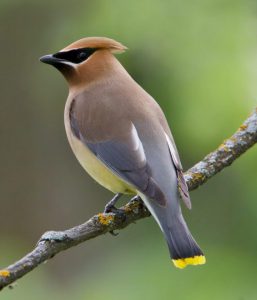
by Daniel J. Leonard | Jan 17, 2020
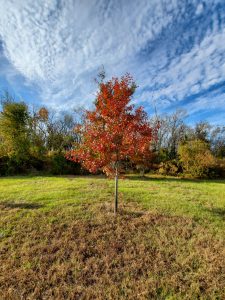
Five Year old Shumard Oak. Photo courtesy the author.
One of the keys to bagging a deer or mess of squirrels or just enjoying an afternoon viewing wildlife is to locate their preferred food source. In the Panhandle, this often means finding a natural stand of oaks or other mast producing trees. However, the concept of attracting animals to mast trees isn’t exclusive to natural areas; it can be replicated by hunters and wildlife enthusiasts to attract whitetail deer, squirrels, turkeys or any other game. (Don’t let the terminology confuse you, “mast” is just a term meaning “fruit from a tree”. “Hard” mast refers to nut producing trees -think Oak, Hickory, etc. Soft mast is just that, soft-fleshed fruits – think Pear, Plum, etc. This piece will focus on hard mast trees.) Regardless of semantics, the takeaway is that planting mast producing trees as winter wildlife attractants have several benefits.
- Enhanced habitat. Planting diverse groups of hard mast producing trees provides wonderful cover for deer to browse, squirrels to nest, and turkeys to roost. Also, groups of trees planted in open areas can help to create desired edge effects, see this publication on benefits of “edge” from Auburn University.
- Excellent nutritional supplement to winter food-plot forages (winter food plots are defined here as open areas planted in the cool season with small forage grains like oats, clover, or ryegrass). If a diversity of species is planted, hard mast trees are an excellent, season-long (approximately October-January) source of proteins and fats. They produce high-energy nutrients deer and other critters need to get through the winter months.
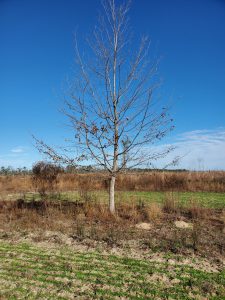
5 year old Sawtooth Oak in December 2019, inter-planted in winter forage plot. Photo courtesy the author.
- Reduction in time and money needing to be spent maintaining annual food plots. A well-designed grove of mast producing trees can be as effective in attracting deer and other animals as winter grazing plots and a whole lot cheaper. A study done by the University of Tennessee Extension in 2008 found that hunters spent about $200 per acre on winter food plots (seed, fertilizer, equipment, time, etc.), an expense that will happen EVERY year. And as many of you know from personal experience, $200 is a VERY conservative number, particularly if you value your personal time at all. Replacing half an acre of cultivated winter forage with mast trees will likely be more expensive in year one when you initially buy and plant but remember, if you do it right, you only have to do it once.
With those benefits of mast trees for wildlife attraction in mind, let’s address what and how to plant. Always select trees with desirable characteristics: long-lived, disease-free, and high-quality mast production at an early age (you don’t want your heirs to get all the benefit!). In the Panhandle, Oaks (Quercus spp.) fit this bill best. There are two groups of Oak to pick from, Red and White. Red Oaks generally have dark, ridged bark, leaves with pointed lobes, small to medium-sized acorns that mature in two seasons, and tend to crop reliably each year. White Oaks possess lighter colored bark, leaves with rounded lobes, large, “sweet” acorns maturing in one season, and tend to produce heavily in alternate years. Plant some of each group to ensure an acorn crop each year and maximize wildlife benefit! However, not just any old oak will do; the Oaks that most closely fit all the above characteristics are:
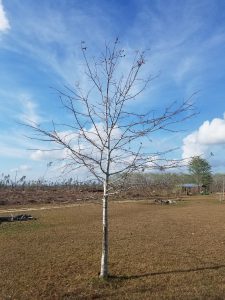
5 year old Nuttall Oak. Photo courtesy the author.
Nuttall Oak (Quercus nuttalli) – Red Oak Group. Rapidly growing, attractive tree, very early producer of good-sized acorns (5-6 years). Drops acorns late, providing needed fats and carbohydrates for bucks through much of the “rut” in the Panhandle (Late November-early February). Tolerates flooding and bottomland areas well.
White Oak (Quercus alba) – White Oak Group. Long-lived, stately tree. Relatively early producer of very large, sweet acorns. Acorn drop is earlier than Nuttall Oak. Grows best on moist upland soils.
Swamp Chestnut Oak (Quercus michauxii) – White Oak Group. Large tree with flaky white/gray bark. Relatively early producer of massive, prized acorns. Acorn drop occurs around the same time as White Oak. Prefers moist upland soils like its cousin the White Oak but will tolerate periodic flooding.
Sawtooth Oak (Quercus acutissima) – White Oak Group. Non-native. Medium-sized tree with heavy branches, often full to the ground. Very early and reliable producer of large, sweet acorns (begins producing at 5-6 years). Begins to drop acorns in September – often the first Oak to produce mast in the season. Grows best on moist upland soils.
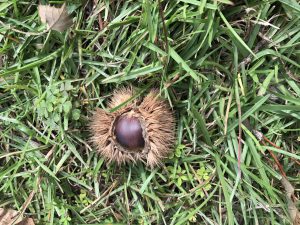
Chinese Chestnut mast in October. Photo courtesy the author.
Chinese Chestnut and Chinese/American Hybrids (Castanea spp.) – Not oaks but worthy of inclusion. Non-native or native hybrids. Medium-sized, spreading trees. Earliest producer of mast (3-4 years from seed germination). Highly sought-after by deer. Tolerates poor soils well but best production is in moist upland areas. I’m particularly partial to the newer American/Chinese Chestnut hybrids like ‘Dunstan’ and ‘AU Buck’.
It is important to remember that success starts at planting. Select healthy container or bare-root trees in the dormant season (December-February) and plant soon after to ensure the rootball doesn’t dry out. Dig planting hole the same depth plants are in containers or to depth of topmost root and backfill with native soil. Do not amend with compost or potting soil! After planting, the trees will need supplemental water, a few gallons per week, unless significant rainfall is received. Water regularly until establishment (when they no longer need your help, generally three-six months after planting).
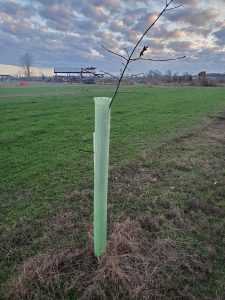
4′ tree grow tubes are effective at protecting young trees from deer browsing. Photo courtesy the author.
Also, recently planted seedlings will need protection from deer browsing. Unfortunately, deer don’t realize these trees will directly benefit them in a few years and will do their best to destroy them by eating the tender new growth or “rubbing” with their antlers, girdling the trees in the process. I’ve found that either a small 4’ high wire cage held together with zip ties works well, as do plastic grow tubes sold by many wildlife providers. If you opt to use grow tubes, secure them with a substantial staking material such as PVC, always carefully look inside when working around the trees as tubes are magnets for wasp nests, and be vigilant in keeping fire ants out (they enjoy building their homes inside the tree tubes, the nests will often reach several feet up the tube, causing major problems for the tree!) Finally, to maximize growth rate of your trees and expedite the mast-producing process, remove competition from the base of trees by pulling weeds or herbicide application and fertilize regularly (when growth emerges in the spring, again in early summer, and again in late summer to early fall).
As always, if you have any other questions or want more information, contact your local UF/IFAS Extension Office. Happy planting!

by hollyober | Oct 10, 2019
Insect pests can destroy substantial quantities of crops, prompting growers to invest heavily in pesticide use. Previ

These three common species of bats in FL, GA, and AL eat insect pests notorious for causing substantial damage to crops: the Seminole bat (Lasiurus seminolus), southeastern bat (Myotis austroriparius), and evening bat (Nycticeius humeralis) (photo credits @MerlinTuttle.org).
ous research in Texas suggested that bats could reduce pesticide costs by over a million dollars within their state, due to the bats’ fondness for pests that damage cotton. Scientists at UF/IFAS recently collected evidence locally that indicates bats are providing valuable assistance with pest reduction for many of the crops grown here too.
During spring and summer of 2018 scientists at UF clarified what the common species of bats were eating in north Florida, south Georgia, and south Alabama. We investigated 161 bats across 21 counties and found that 28% of these bats ate at least one Lepidopteran (moth) pest species, 21% ate a Coleopteran (beetle) pest, and 18% ate a Hemipteran (true bug) pest. In total, 12 different species of agricultural pest species were eaten by these bats.
The moth pests consumed by bats were:
- Green Cutworm Moth (Anicla infecta)
- Tobacco Budworm (Chloridea virescens)
- Soybean Looper (Chrysodeixis includens)
- Garden Tortrix (Clepsis peritana)
- Lesser Cornstalk Borer (Elasmopalpus lignosellus)
- Corn Earworm (Helicoverpa zea)
- Beet Armyworm (Spodoptera exigua)
- Fall Armyworm (Spodoptera frugiperda)
- Red-Necked Peanutworm Moth (Stegasta bosqueella)
The beetle and true bug pests consumed by bats were:
- Hairy Fungus Beetle (Typhaea stercorea)
- Tarnished Plant Bug (Lygus lineolaris)
- Two-lined Spittlebug (Prosapia bicincta)
Three of these pests (Soybean Looper, Beet Armyworm, and Two-lined Spittlebug) were most often consumed by pregnant and juvenile bats. This is good news for growers of crops affected by these pests because you have a sound option for increasing the likelihood of bats helping control them. The trick is to provide the conditions that adult female bats like near the crops these pests feed on (e.g., soybeans, peanut, cotton, corn, sorghum, safflower). Most female bats pick a maternity roost in early spring. A maternity roost is a structure that provides warm, dry, dark conditions for female bats to sleep in during the day, and it is ultimately where they give birth to pups. When selecting a site to set up a maternity roost, female bats look for structures that are large enough to provide shelter for a large number of bats. A roomy structure can accommodate many bats, which allows the flightless pups to keep each other warm while the mothers fly in search of food at night. Installing a bat house like those shown here can provide conditions appropriate for a maternity colony, increasing your chances of having bats help control these insect pests.
Another useful strategy for enhancing pest control services by bats involves creating or maintaining structures that could serve as natural roost sites for bats. The natural structures bats prefer include large trees with cavities, dead and dying trees with peeling bark, oak trees with Spanish moss, and palm trees allowed to maintain their dead fronds. In agricultural areas and suburban areas these types of trees are often in short supply.
Maintaining large, old trees of a mix of species, and supplementing with bat houses, can help ensure there are plenty of roosting options for bats. This, in turn, will increase the likelihood that bats are available to assist with your pest management.
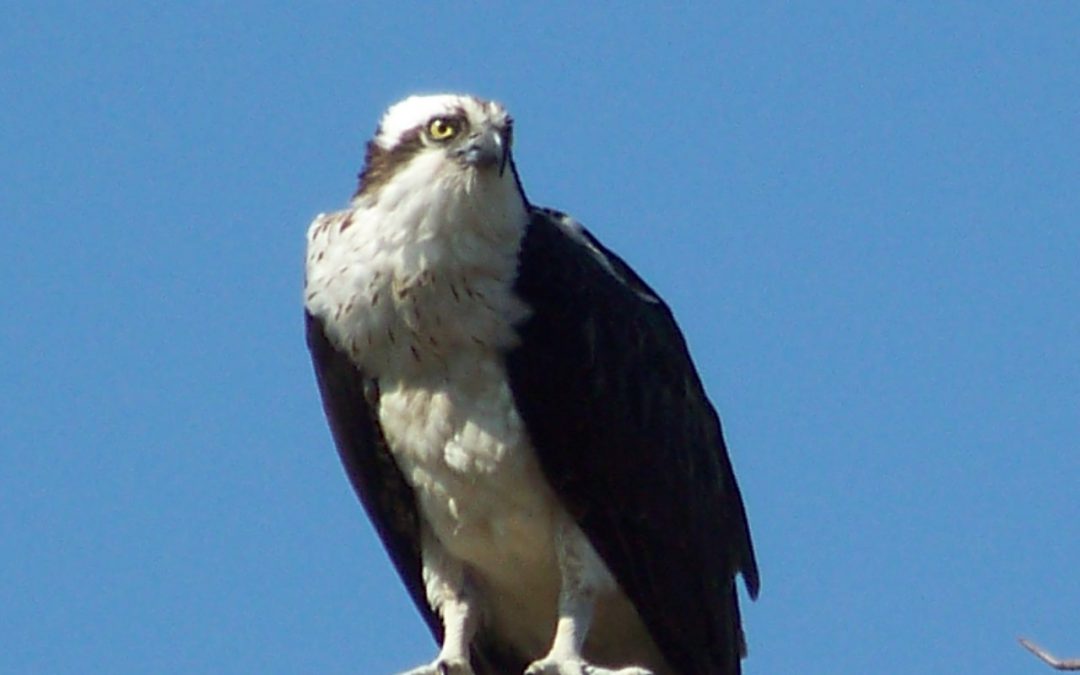
by Carrie Stevenson | Sep 27, 2019
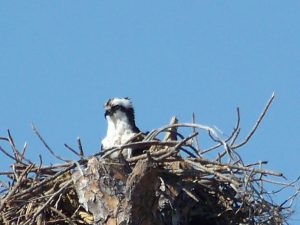
Ospreys, or fish hawks, build their nests from sticks atop dead trees. Photo credit: UF IFAS Extension
Big hurricanes like Dorian (Bahamas) and 2018’s Michael (central Florida Panhandle) were devastating to the communities they landed in. Flooding, wind, rain, loss of power and communications eventually made way for ad hoc clearing and cleanup, temporary shelters, and a slow walk to recovery. Among the most striking visual impacts of a hurricane are the tree losses, as there are unnatural openings in the canopy and light suddenly shines on areas that had been shaded for years. In northwest Florida, pines are particularly vulnerable. After any hurricane in the Panhandle, you can drive down Interstate 10 for miles and see endless pines blown to the ground or broken off at the top. During Hurricane Ivan 15 years ago, the coastal areas in Escambia and Santa Rosa lost thousands of trees not only due to wind, but also to tree roots inundated by saltwater for long periods.
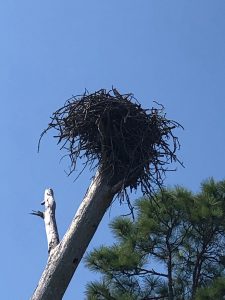
Dead trees left by hurricanes serve as ideal nesting ground for large birds like ospreys. Photo credit: Carrie Stevenson, UF IFAS Extension
Nature always finds a way, though. Because of all those dead (but still-standing) pines, our osprey (Pandion haliaetus) population is in great shape in the Pensacola area. How are these two things related? Well, ospreys build large stick nests in the tall branches/crooks of dead trees, known as snags. They particularly prefer those near the water bodies where they fish. When I first moved here 20 years ago, I rarely saw ospreys. Now, it’s uncommon not to see them near the bayous and bays, or to hear their high-pitched calls as they swoop and dive for fish.
If you are not familiar with ospreys, they can be distinguished by their call and their size (up to six foot wingspan). It is common to see them in their large nests atop those snags, flying, or diving for fish. I usually see them with mullet in their talons, although they also prey on catfish, spotted trout, and other smaller species. They have white underbellies, brown backs, and are smaller than eagles but larger than your average hawk. One of their more interesting physical adaptations (and identifying characteristics) is their ability to grip fish parallel to their bodies, making it more aerodynamic than the perpendicular method most birds use.
Ospreys mate for life, and cooperate to build nests and care for young. The species has overcome many complex threats—including DDT damage to eggs and habitat loss—but the sight of them flying is always inspiring to me. They are a living embodiment of resilience amidst adversity.
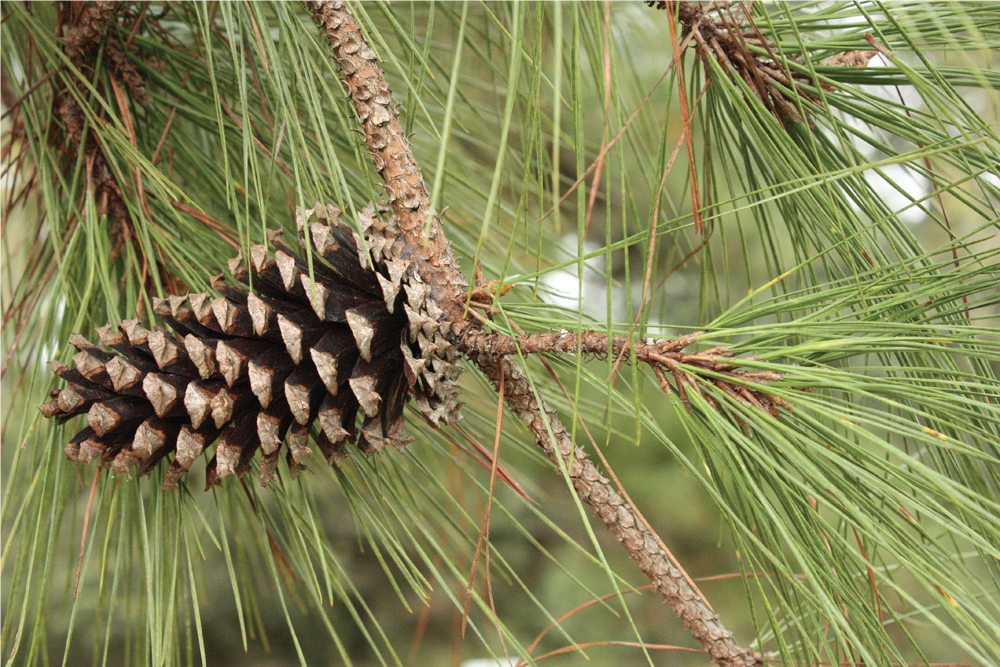
by Sheila Dunning | Apr 18, 2019
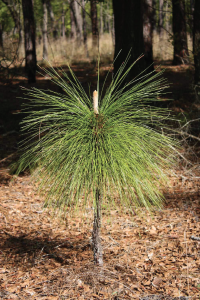
Young Longleaf Pine
All of Florida’s ecosystems contain pine trees. There are seven native species in the state; Sand, Slash, Spruce, Shortleaf, Loblolly, Longleaf, and Pond. Each species grows best in its particular environment. Pines are highly important to wildlife habitats as food and shelter. Several species are equally valuable to Florida’s economy. Slash, Loblolly, and Longleaf are cultivated and managed to provide useful products such as paper, industrial chemicals, and lumber. All pines are evergreens, meaning they keep foliage year-round. The leaves emerge from the axil of each scale leaf into long slender needles clustered together in bundles. Needles are produced at the growing tips of each branch and remain on the tree for several years before turning reddish-brown and falling off. The bundles are referred to as “fascicles”. The length and number of needles in each fascicle is one way to help identify the different pine species.
A handy rule of thumb is that pines starting with “S” have needles in twos, while pines starting with “L” have needles in threes. And slash pine, which starts with “SL” has needles in twos and threes. The pond pine is also a three-needled fascicle. Pay attention to their length and the number that are held in a fascicle. Because the numbers per fascicle may vary, be sure to check several fascicles to get an overall sense for the plant! Longleaf has the longest needle, measuring over 10 inches. While sand pine has the shortest needles at around 2 inches in length. Pine cones are also a means for identification. Typically the longer the needle, the bigger the cone. But, they also vary in attachment and “spinyness’.
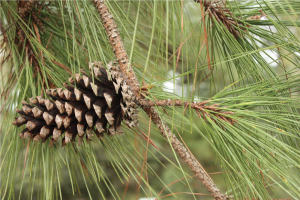
Cone of Loblolly Pine, attached directly to the stem
The outer (dorsal) surface of each seed cone scale has a diamond-shaped bulge, or “umbo,” formed by the first year’s growth. The umbo may or may not be armored with a “prickle,” a sharp point but not quite a spine or thorn, at the tip. As the seed cone continues to grow and expand, the exposed area at the end of each scale grows as well. The larger diamond-shaped area around the umbo, formed in the second year of growth, is called the “apophysis.” The shapes of the prickle, umbo, and apophysis can be helpful in identification. The male and female cones are separate structures, but both are present on the same plant. Pollen is produced by male cones and is carried by the wind to female cones where it fertilizes the ovules. Seeds develop and mature inside the female cones (also called the seed cones) for two years, protected by a series of tightly overlapping woody scales. Some pines open their seed cones after two years to release the seeds, while other pines continue to keep their cones tightly closed past maturity and release seeds in response to the heat of a forest fire.
To learn more about Florida’s pines and helpful hint on identification go to:
http://edis.ifas.ufl.edu/pdffiles/fr/fr00300.pdf
by Sheila Dunning | Jan 4, 2019
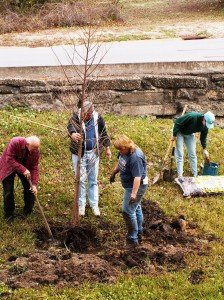
Tree planting in Mary Esther
The best time to plant a tree is twenty years ago. The second best time is for Arbor Day. Florida recognizes the event on the third Friday in January, but planting any time before spring will establish a tree quickly. Arbor Day is an annual observance that celebrates the role of trees in our lives and promotes tree planting and care. As a formal holiday, it was first observed on April 10, 1872 in the state of Nebraska. Today, every state and many countries join in the recognition of trees impact on people and the environment. Trees are the longest living organisms on the planet and one of the earth’s greatest natural resources. They keep our air supply clean, reduce noise pollution, improve water quality, help prevent erosion, provide food and building materials, create shade, and help make our landscapes look beautiful. A single tree produces approximately 260 pounds of oxygen per year. That means two mature trees can supply enough oxygen annually to support a family of four. The idea for Arbor Day in the U.S. began with Julius Sterling Morton. In 1854 he moved from Detroit to the area that is now the state of Nebraska. J. Sterling Morton was a journalist and nature lover who noticed that there were virtually no trees in Nebraska. He wrote and spoke about environmental stewardship and encouraged everyone to plant trees. Morton emphasized that trees were needed to act as windbreaks, to stabilize the soil, to provide shade, as well as, fuel and building materials for the early pioneers to prosper in the developing state. In 1872, The State Board of Agriculture accepted a resolution by J. Sterling Morton “to set aside one day to plant trees, both forest and fruit.” On April 10, 1872 one million trees were planted in Nebraska in honor of the first Arbor Day. Shortly after the 1872 observance, several other states passed legislation to observe Arbor Day. By 1920, 45 states and territories celebrated Arbor Day. Richard Nixon proclaimed the last Friday in April as National Arbor Day during his presidency in 1970. Today, all 50 states in the U.S. have official Arbor Day, usually at a time of year that has the correct climatological conditions for planting trees. For Florida, the ideal tree planting time is January, so Florida’s Arbor Day is celebrated on the third Friday of the month. Similar events are observed throughout the world. In Israel it is the Tu B Shevat (New Year for Trees). Germany has Tag des Baumes. Japan and Korea celebrate an entire week in April. Even, Iceland one of the most treeless countries in the world observes Student’s Afforestation Day. The trees planted on Arbor Day show a concern for future generations. The simple act of planting a tree represents a belief that the tree will grow and some day provide wood products, wildlife habitat erosion control, shelter from wind and sun, beauty, and inspiration for ourselves and our children.

Trees provide us with benefits including serving as a sound barrier, stormwater abatement, and of course fresh air and oxygen
“It is well that you should celebrate your Arbor Day thoughtfully, for within your lifetime the nation’s need of trees will become serious. We of an older generation can get along with what we have, though with growing hardship; but in your full manhood and womanhood you will want what nature once so bountifully supplied and man so thoughtlessly destroyed; and because of that want you will reproach us, not for what we have used, but for what we have wasted.”
~Theodore Roosevelt, 1907 Arbor Day Message
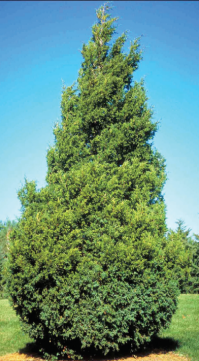
by Sheila Dunning | Dec 19, 2018
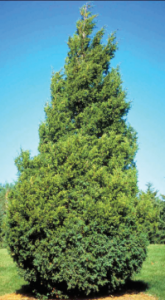 Throughout history the evergreen tree has been a symbol of life. “Not only green when summer’s here, but also when it’s cold and dreary” as the Christmas carol “O Tannenbaum” says. After such devastating tree losses in the Panhandle this year, this winter is a prime time for installing more native evergreens.
Throughout history the evergreen tree has been a symbol of life. “Not only green when summer’s here, but also when it’s cold and dreary” as the Christmas carol “O Tannenbaum” says. After such devastating tree losses in the Panhandle this year, this winter is a prime time for installing more native evergreens.
While supporting the cut Christmas tree industry does create jobs and puts money into local economics, every few years considering adding to the urban forest by purchasing a living tree. Native evergreen trees such as Redcedar make a nice Christmas tree that can be planted following the holidays. The dense growth and attractive foliage make Redcedar a favorite for windbreaks, screens and wildlife cover. The heavy berry production provides a favorite food source for migrating Cedar Waxwing birds. Its high salt-tolerance makes it ideal for coastal locations. Their natural pyramidal-shape creates the traditional Christmas tree form, but can be easily pruned as a street tree.
Two species, Juniperus virginiana and Juniperus silicicola are native to Northwest Florida. Many botanists do not separate the two, but as they mature, Juniperus silicicola takes on a softer, more informal look. For those interested in creating a different look, maybe a Holly (Ilex,sp.) or Magnolia with full-to-the-ground branches could be your Christmas tree.
When planning for using a live Christmas tree there are a few things to consider. The tree needs sunlight, so restrict its inside time to less than a week. Make sure there is a catch basin for water under the tree, but never allow water to remain in the tray and don’t add fertilizer. Locate your tree in the coolest part of the room and away from heating ducts and fireplaces. After Christmas, install the new tree in an open, sunny part of the yard. After a few years you will be able to admire the living fence with all the wonderful memories of many years of holiday celebrations. Don’t forget to watch for the Cedar Waxwings in the Redcedar.